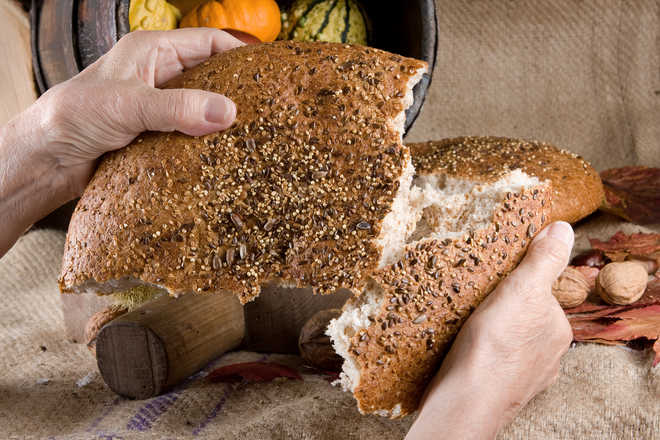
If you want atta bread and not refined flour (maida) with colour, ask for ‘whole wheat’ and not brown bread
Ishi Khosla
The aroma of fresh bread is truly irresistible. Bread consumption over the years has been on the increase both in urban and rural settings. In fact, the number of varieties, which one sees these days, is mind boggling and there are eateries specialising only in bread making. What is it about bread that makes it such an all-time favourite through generations all over the world; for many even a craving!
Unleavened bread like chapattis was the first bread. The inventions of leavened bread are attributed to the ancient Egyptians. It became a staple of the standard European/ American diet. Leavened bread is prepared with yeast or baking soda to make the dough rise before baking.
Usually, bread is named after the grain from which the flour or meal is derived. There are also variety of flavours and seasonings added. These could range from garlic, cheese, onion, rosemary, dill, sundried tomatoes, pesto, olives, sesame and poppy seeds. Many varieties available also indicate the ethnic diversity of bread: buns, rolls, bagels, baguettes, focaccia, multi-grain, sour-dough and whole wheat/brown are a few of the varieties known in India. Variety of flours, including oats, soybean, barley, millets, ragi etc. can also be added to whole wheat flour to make different kinds of breads.
In the US, bread may be made with non-digestible fibres or resistant starches such as cellulose, inulin, guar gum or powdered cellulose as a non-calorie filler to lower calories. In India breads are also being made with alternate flours to lower their glycemic index (GI). Wheat flour is ideal for leavened bread because wheat contains, gluten, a protein that becomes sticky when mixed with water. Dough made from wheat flour is elastic enough to rise, as bubbles of carbon dioxide become trapped, thus creating light-textured bread. In contrast, breads made with only low-gluten flours will tend to be heavy (dense).
Other varieties include wholemeal bread (ground grains along with refined white flour), wholegrains, allergen-free breads (gluten, dairy and soy–free), sour-dough, low GI, Omega-3, cholesterol-lowering bread, prebiotic, phytoestrogen-rich and fortified breads. These are not easily available in our country. Interestingly, the demand for gluten-free breads and bakery has grown tremendously worldwide in the last decade. According to reports, the market has seen a double-digit growth in 2015 and is estimated to grow rapidly by 2020. This is owing to the rise in number of people being diagnosed with gluten sensitivity (celiac or non-celiac).
People now are also looking out for ingredients like naturally gluten-free grains, either the traditional ones like millets, amaranth and ragi or exotic imported ones like buckwheat, red rice, spelt, kamut or teff. Super-food enrichment is becoming a selling point in the more developed markets like sweet potato, kale, flax and chia.
Other ingredients used in the bread industry are sugar, bran, milk, oil, emulsifiers bread improvers and preservatives. Potassium bromate or iodate is commonly used to improve bread texture and enhance gluten effect. However, owing to their safety concerns, several countries in the European Union (EU) have banned their use while others like India regulate the levels that can be permitted. These additives have been classified as possible carcinogens in humans when taken above permissible levels. According to WHO/FAO expert committee, use of potassium bromated in bread is not appropriate. Potassium iodate is also a concern as in excess it can impact thyroid gland function. It is commonly used to iodize salt to prevent goitre.
Bread is one of the good sources of complex carbohydrates. If bread is made from low glycemic index ingredients like oats, nuts, bran, soy and pulses, it has a metabolically favourable impact on our blood sugars and body weight.
These digest slowly to form the simple sugar (glucose). The slow rise in blood sugar requires a modest output of the hormone insulin to regulate blood sugar and fat levels. This also helps in keeping you full for longer.
Also ask for “whole wheat” not brown if you want an atta bread and not refined flour (maida) with colour. So, be breadwise next time you go bread shopping.
— The writer is a clinical nutritionist and founder, www.theweightmonitor.com
Brown vs White
2,000 years of debate
Hippocrates, the father of medicine, advised his health patrons and patients to follow the practice of their servants and eat whole wheat bread “for its sanitary on the bowel.” White bread is prepared from bleached flour (maida), which is highly refined (purified). Milling and bleaching partially removes the germ (nutrient-rich part of grain) and the bran (fibre rich part) leaving mainly the starch rich endosperm.
This leads to loss of more than 22 important nutrients such as fiber, vitamins, and minerals. In advanced countries of the world, flour is so widely used that some bakeries follow flour enrichment and replace four vitamins namely: thiamin, niacin, riboflavin and iron. Other nutrients, such as vitamin B6, zinc, manganese, and folic acid are not added. Since in these countries, white bread contains nearly half a gram of fibre a slice, some bakeries increase the fibre content by adding dates, raisins, bran or purified powdered cellulose.
Crystalline cellulose may not provide the same fibre benefits in the body as the natural cellulose that occurs in the bran of whole wheat bread. Whole-grain breads provide two or three grams of fibre per slice. Bread labelled “whole wheat” must contain 100 per cent whole wheat as the first listed ingredient. Bread simply labelled as “wheat” or “cracked wheat” often contains white flour as the major ingredient; the brown colour of such bread may be due to caramel or artificial colouring. Bread labelled “multi-grain” may simply mean that the bread contains mainly refined wheat flour with small amounts of oatmeal, rye, or whole wheat. The label should indicate whether caramel colouring has been added to give the bread a more wholesome appearance.



























